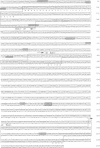Abstract
The genes for the alpha 5(IV) and alpha 6(IV) chains of human basement membrane collagen type IV have been found together on chromosome X at segment q22 and have been reported to be arranged in a head-to-head fashion. Here we report the 5' flanking sequences of COL4A5 and COL4A6 and that COL4A6 is transcribed from two alternative promoters in a tissue-specific fashion. Analysis of the sequence immediately upstream of the transcription start sites revealed some features of housekeeping genes--i.e., the lack of a TATA motif and the presence of CCAAT and CTC boxes. Further analysis revealed that COL4A6 contains two alternative promoters that control the generation of two different transcripts. One transcription start site (from exon 1') is 442 bp away from the transcription start site of COL4A5, while an alternative transcription start site (from exon 1) is located 1050 bp from the first one and drives the expression of a second transcript that encodes an alpha 6(IV) chain with a different signal peptide. Reverse transcription-PCR experiments revealed that the transcript from exon 1' is abundant in placenta, whereas the transcript from exon 1 is more frequently found in kidney and lung. These results provide additional clues to answering the general question of what mechanisms are used to generate unique basement membrane structures in different tissues.
Full text
PDF
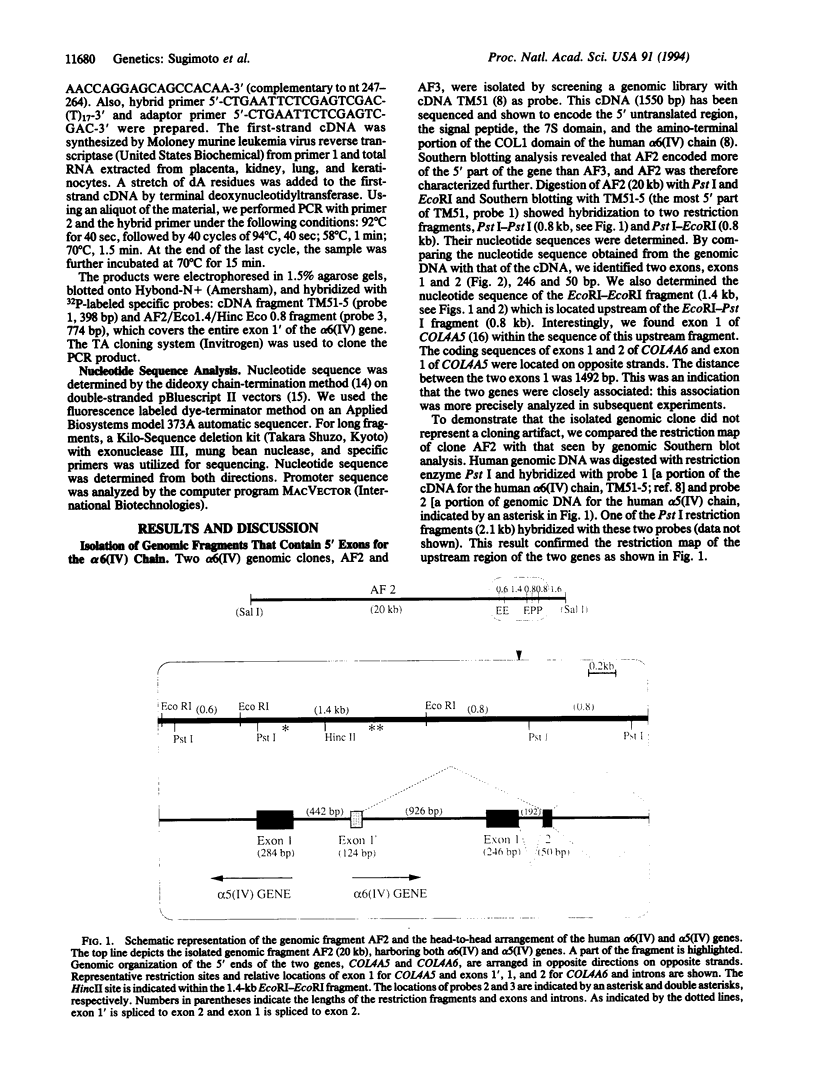
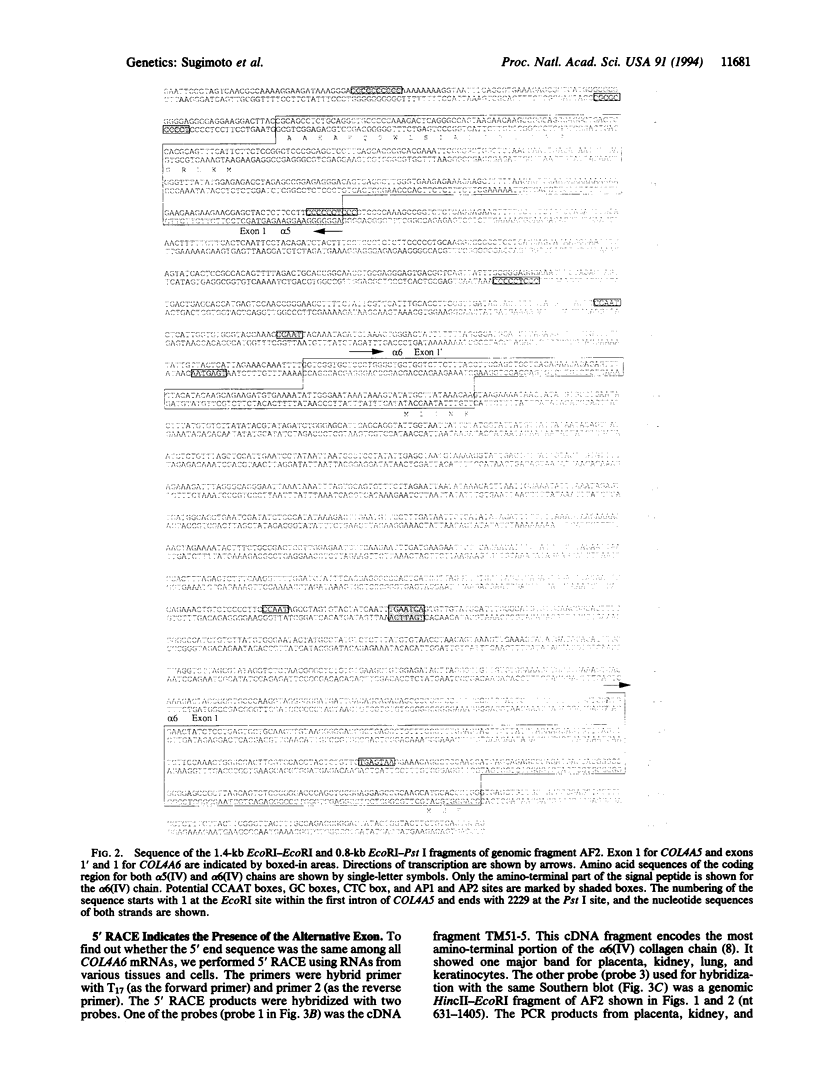
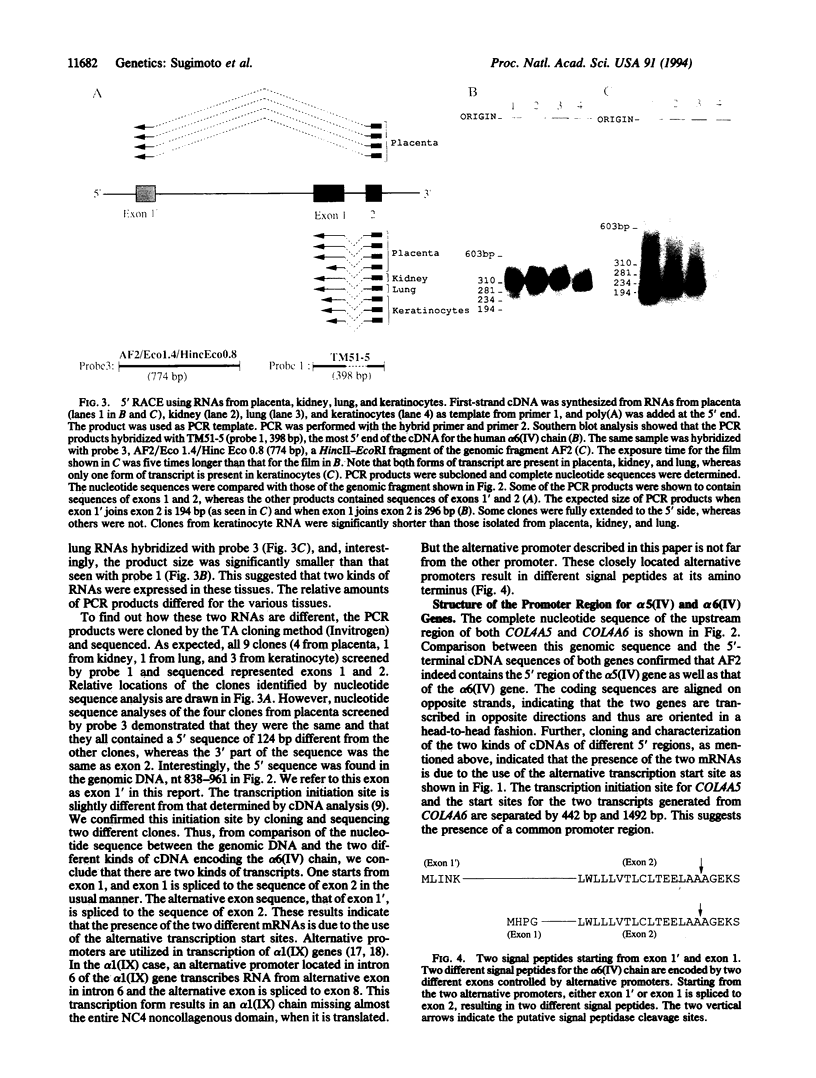
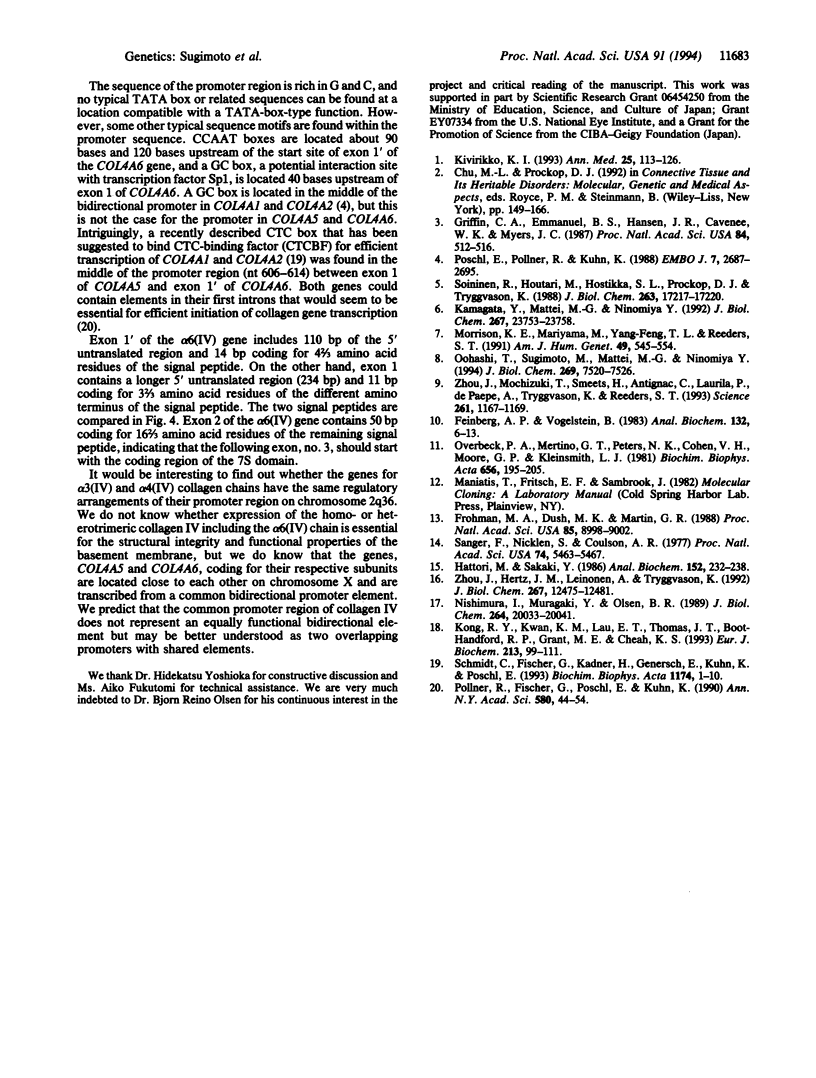
Images in this article
Selected References
These references are in PubMed. This may not be the complete list of references from this article.
- Feinberg A. P., Vogelstein B. A technique for radiolabeling DNA restriction endonuclease fragments to high specific activity. Anal Biochem. 1983 Jul 1;132(1):6–13. doi: 10.1016/0003-2697(83)90418-9. [DOI] [PubMed] [Google Scholar]
- Frohman M. A., Dush M. K., Martin G. R. Rapid production of full-length cDNAs from rare transcripts: amplification using a single gene-specific oligonucleotide primer. Proc Natl Acad Sci U S A. 1988 Dec;85(23):8998–9002. doi: 10.1073/pnas.85.23.8998. [DOI] [PMC free article] [PubMed] [Google Scholar]
- Griffin C. A., Emanuel B. S., Hansen J. R., Cavenee W. K., Myers J. C. Human collagen genes encoding basement membrane alpha 1 (IV) and alpha 2 (IV) chains map to the distal long arm of chromosome 13. Proc Natl Acad Sci U S A. 1987 Jan;84(2):512–516. doi: 10.1073/pnas.84.2.512. [DOI] [PMC free article] [PubMed] [Google Scholar]
- Hattori M., Sakaki Y. Dideoxy sequencing method using denatured plasmid templates. Anal Biochem. 1986 Feb 1;152(2):232–238. doi: 10.1016/0003-2697(86)90403-3. [DOI] [PubMed] [Google Scholar]
- Kamagata Y., Mattei M. G., Ninomiya Y. Isolation and sequencing of cDNAs and genomic DNAs encoding the alpha 4 chain of basement membrane collagen type IV and assignment of the gene to the distal long arm of human chromosome 2. J Biol Chem. 1992 Nov 25;267(33):23753–23758. [PubMed] [Google Scholar]
- Kivirikko K. I. Collagens and their abnormalities in a wide spectrum of diseases. Ann Med. 1993 Apr;25(2):113–126. doi: 10.3109/07853899309164153. [DOI] [PubMed] [Google Scholar]
- Kong R. Y., Kwan K. M., Lau E. T., Thomas J. T., Boot-Handford R. P., Grant M. E., Cheah K. S. Intron-exon structure, alternative use of promoter and expression of the mouse collagen X gene, Col10a-1. Eur J Biochem. 1993 Apr 1;213(1):99–111. doi: 10.1111/j.1432-1033.1993.tb17739.x. [DOI] [PubMed] [Google Scholar]
- Morrison K. E., Mariyama M., Yang-Feng T. L., Reeders S. T. Sequence and localization of a partial cDNA encoding the human alpha 3 chain of type IV collagen. Am J Hum Genet. 1991 Sep;49(3):545–554. [PMC free article] [PubMed] [Google Scholar]
- Nishimura I., Muragaki Y., Olsen B. R. Tissue-specific forms of type IX collagen-proteoglycan arise from the use of two widely separated promoters. J Biol Chem. 1989 Nov 25;264(33):20033–20041. [PubMed] [Google Scholar]
- Oohashi T., Sugimoto M., Mattei M. G., Ninomiya Y. Identification of a new collagen IV chain, alpha 6(IV), by cDNA isolation and assignment of the gene to chromosome Xq22, which is the same locus for COL4A5. J Biol Chem. 1994 Mar 11;269(10):7520–7526. [PubMed] [Google Scholar]
- Overbeek P. A., Merlino G. T., Peters N. K., Cohn V. H., Moore G. P., Kleinsmith L. J. Characterization of five members of the actin gene family in the sea urchin. Biochim Biophys Acta. 1981 Dec 28;656(2):195–205. doi: 10.1016/0005-2787(81)90087-3. [DOI] [PubMed] [Google Scholar]
- Pollner R., Fischer G., Pöschl E., Kühn K. Regulation of divergent transcription of the genes coding for basement membrane type IV collagen. Ann N Y Acad Sci. 1990;580:44–54. doi: 10.1111/j.1749-6632.1990.tb17916.x. [DOI] [PubMed] [Google Scholar]
- Pöschl E., Pollner R., Kühn K. The genes for the alpha 1(IV) and alpha 2(IV) chains of human basement membrane collagen type IV are arranged head-to-head and separated by a bidirectional promoter of unique structure. EMBO J. 1988 Sep;7(9):2687–2695. doi: 10.1002/j.1460-2075.1988.tb03122.x. [DOI] [PMC free article] [PubMed] [Google Scholar]
- Sanger F., Nicklen S., Coulson A. R. DNA sequencing with chain-terminating inhibitors. Proc Natl Acad Sci U S A. 1977 Dec;74(12):5463–5467. doi: 10.1073/pnas.74.12.5463. [DOI] [PMC free article] [PubMed] [Google Scholar]
- Schmidt C., Fischer G., Kadner H., Genersch E., Kühn K., Pöschl E. Differential effects of DNA-binding proteins on bidirectional transcription from the common promoter region of human collagen type IV genes COL4A1 and COL4A2. Biochim Biophys Acta. 1993 Jul 18;1174(1):1–10. doi: 10.1016/0167-4781(93)90085-r. [DOI] [PubMed] [Google Scholar]
- Soininen R., Huotari M., Hostikka S. L., Prockop D. J., Tryggvason K. The structural genes for alpha 1 and alpha 2 chains of human type IV collagen are divergently encoded on opposite DNA strands and have an overlapping promoter region. J Biol Chem. 1988 Nov 25;263(33):17217–17220. [PubMed] [Google Scholar]
- Zhou J., Hertz J. M., Leinonen A., Tryggvason K. Complete amino acid sequence of the human alpha 5 (IV) collagen chain and identification of a single-base mutation in exon 23 converting glycine 521 in the collagenous domain to cysteine in an Alport syndrome patient. J Biol Chem. 1992 Jun 25;267(18):12475–12481. [PubMed] [Google Scholar]
- Zhou J., Mochizuki T., Smeets H., Antignac C., Laurila P., de Paepe A., Tryggvason K., Reeders S. T. Deletion of the paired alpha 5(IV) and alpha 6(IV) collagen genes in inherited smooth muscle tumors. Science. 1993 Aug 27;261(5125):1167–1169. doi: 10.1126/science.8356449. [DOI] [PubMed] [Google Scholar]




